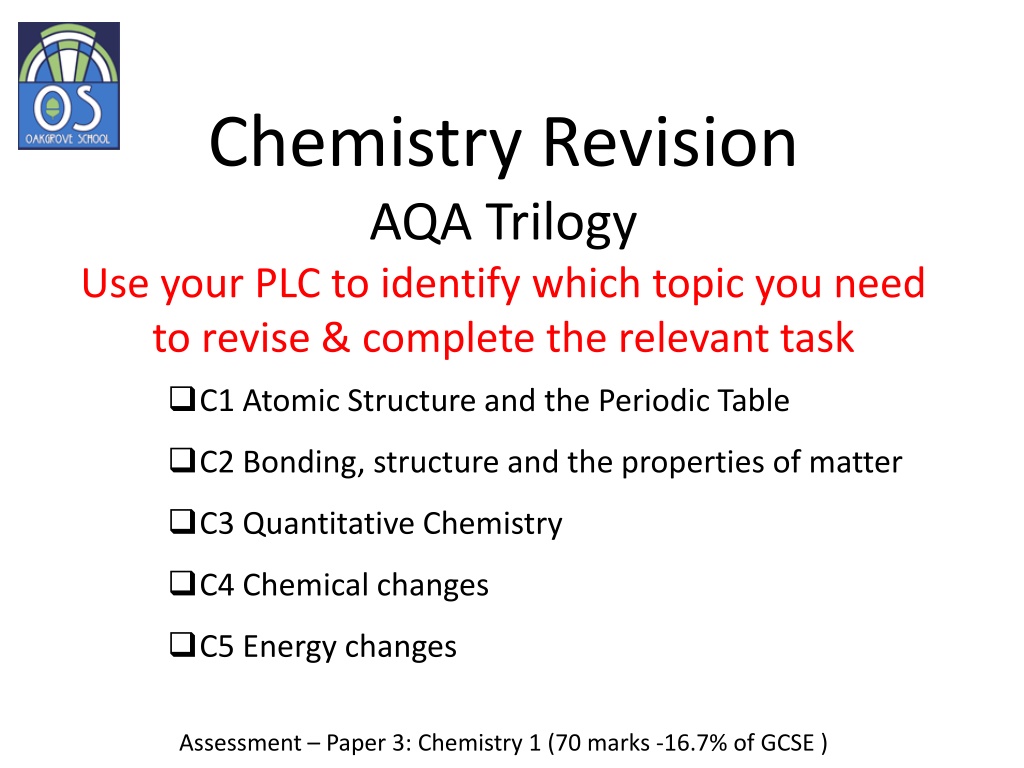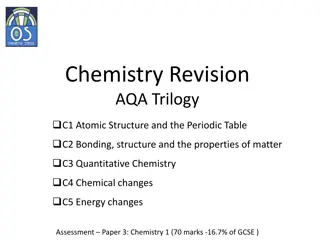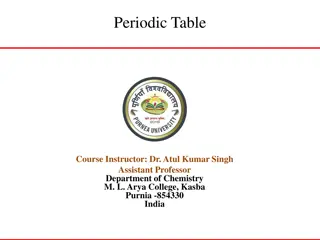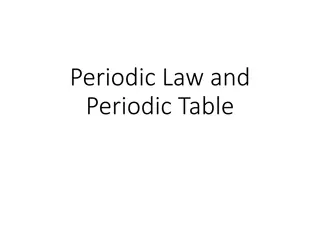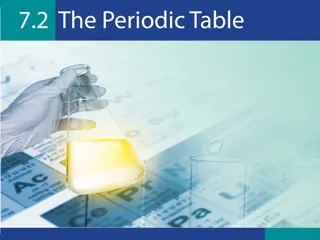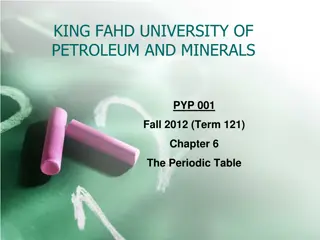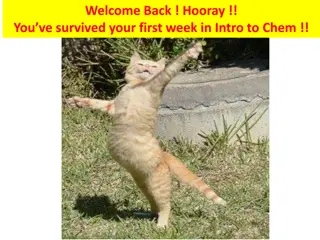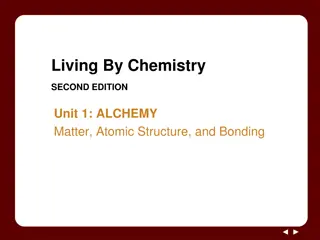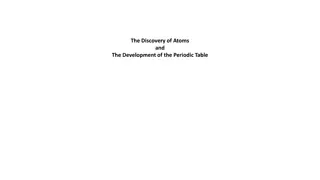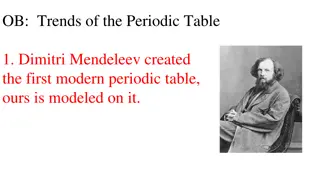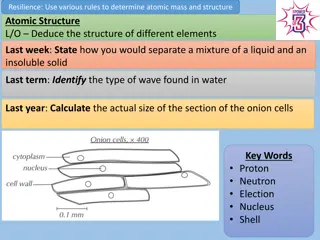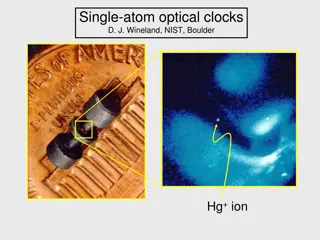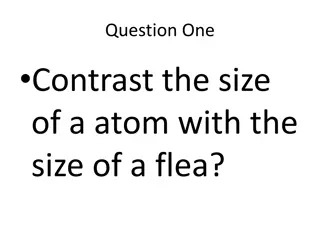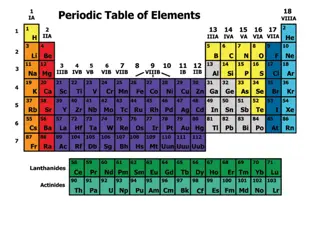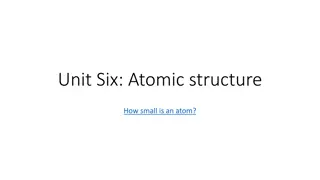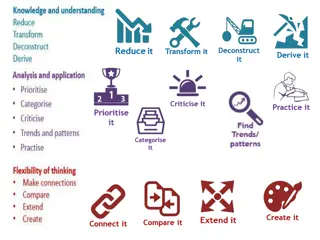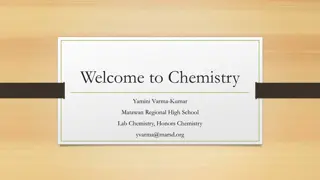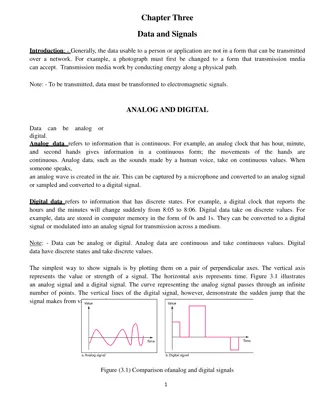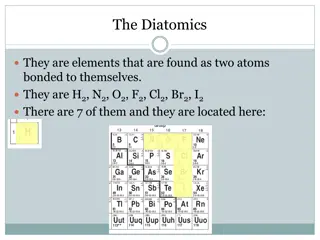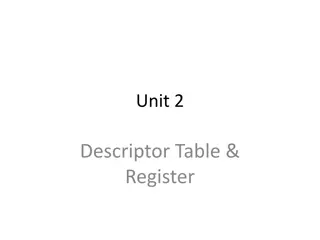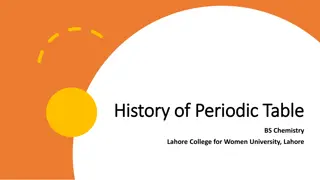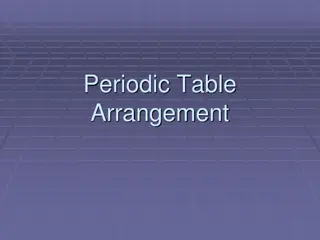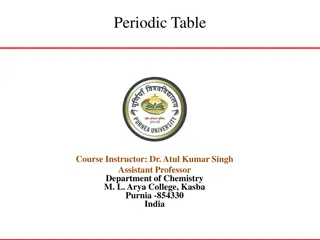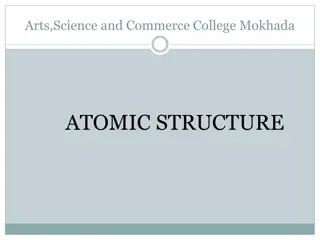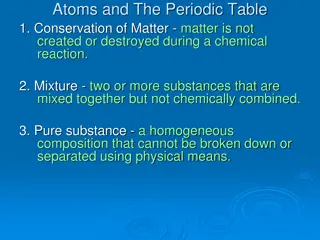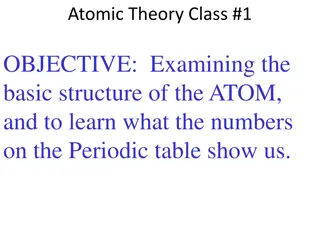AQA Trilogy Chemistry Revision: Atomic Structure and Periodic Table
This content focuses on revising key topics in AQA Trilogy Chemistry such as atomic structure, periodic table, separation techniques, symbol equations, and isotopes. Learn about elements, electron structures, reactivity trends, and relative atomic mass calculations.
Download Presentation

Please find below an Image/Link to download the presentation.
The content on the website is provided AS IS for your information and personal use only. It may not be sold, licensed, or shared on other websites without obtaining consent from the author. Download presentation by click this link. If you encounter any issues during the download, it is possible that the publisher has removed the file from their server.
E N D
Presentation Transcript
Chemistry Revision AQA Trilogy Use your PLC to identify which topic you need to revise & complete the relevant task C1 Atomic Structure and the Periodic Table C2 Bonding, structure and the properties of matter C3 Quantitative Chemistry C4 Chemical changes C5 Energy changes Assessment Paper 3: Chemistry 1 (70 marks -16.7% of GCSE )
Write the word equation for: Burning magnesium in air Explain crystallisation as a separation technique C1 Atomic Structure and the Periodic Table AQA Trilogy Can you write the balanced symbol equation? Draw a diagram to illustrate chromatography as a separation technique Define the following terms: Atom Balance the symbol equations below: H2SO4 + NaOH Na2SO4 + H2O Element Number of protons = Zn + O2 ZnO Compound Number of neutrons = CH4 + O2 CO2 + H2O Mixture Number of electrons = Simple distillation Explain simple distillation as a separation technique, shown in the diagram Write the symbols for the following elements: Describe the difference between the plum pudding and the nuclear model of an atom Oxygen Carbon Sodium Magnesium Chlorine Copper Explain fractional distillation as a separation technique Write the name of the compound: CO2 Where in an atom are the neutrons and proton? The number of protons = the number of_________ Atomic number is the number of _________ Mass number is the number of ________ + the number of _________ Isotopes have a different number of ____________ fractional distillation H2O NaCl CuSO4
In the periodic table, the elements are arranged in order of their ___________ number When developing the periodic table, Why did Medeleev leave gaps? Properties of metals C1 Atomic Structure and the Periodic Table AQA Trilogy Elements in the same group, have the same number of ______________ Groups go ____________ Approximately how may elements are in the periodic table? Periods go ___________ Draw the electron structure for sodium What is group 1 also known as? Delete as appropriate: Properties of non-metals As you go down group 1, what happens to the reactivity? If you remove electrons from an atom is becomes positive/ negative If you add electrons to an atom it becomes positive/negative How many electrons are in the outer shell of a group 1 metal? What is group 7 also known as? Draw the electron structure for chlorine What is an isotope? To work out the relative atomic mass using the abundance of isotopes we can use the following calculation: As you go down group 7, what happens to the reactivity? (% of isotope 1 mass of isotope 1) + (% of isotope 2 mass of isotope 2) 100 What happens to melting point and boiling point as you go down the group? How many electrons are in the outer shell of a group 7 element? Copper has two stable isotopes Cu-63 which has an abundance of 69.2% and Cu-65 which has an abundance of 30.8% Calculate relative atomic mass to 1dp. Draw the electron structure for chlorine What is group 0 also know as? In any sample of Chlorine 25% will be37Cl and 75%35Cl. Calculate the relative atomic mass to 1dp. In group 0, how many electrons are in the outer shell? How is boiling point affected as you go down the group?
Ionic bonding Covalent bonding Draw the dot and cross diagram to show the covalent bonding in Nl2 C2 Bonding, structure and the properties of matter AQA Trilogy Describe ionic bonding Describe covalent bonding What bonds together? What bonds together? Define the following terms: Ion Ionic bonding is represented with dot and cross diagrams Covalent bonding is represented with dot and cross diagrams. The covalent bond between two hydrogen atoms is shown below: Draw the dot and cross diagram to show the covalent bonding in H2O Electrostatic force Sodium chloride is shown below: Polymer Allotrope Write the charge of the following atoms when they form ions: Na Mg Cl K O Br S Ca Draw the dot and cross diagram for magnesium oxide (MgO) Draw the dot and cross diagram to show the covalent bonding in Cl2 Draw the dot and cross diagram to show the covalent bonding in CH4 Give properties of ionic compounds Draw the dot and cross diagram for magnesium chloride (MgCl2) Draw the dot and cross diagram to show the covalent bonding in O2 Draw the dot and cross diagram to show the covalent bonding in HCl
Diamond Number of covalent bonds from each carbon Metallic bonding Describe metallic bonding Metallic bonding C2 Bonding, structure and the properties of matter AQA Trilogy Melting point is low / high / very high Why doesn t it conduct electricity? What bonds together? There are several ways to represent covalent bonds: Graphite Number of covalent bonds from each carbon Why are most metals: solid at room temperature? Draw a diagram to show why alloys are harder than pure metals Melting point is low / high / very high Good conductors of electricity and heat Why does it conduct electricity? The repeating unit of poly(ethene) is shown below. What is the molecular formula of poly(ethene) Write about the uses of Fullerenes like Bucky balls and nanotubes Draw a diagram to show why most metals are malleable Predict the state of: Bromine at room temperature (25oC) Nitrogen at room temperature (25oC) Oxygen at 220oC Ethanol melts at -114oC and boils at 78oC. Predict the state at: The reason that most polymers are solid at room temperature is: Name the process: Solid liquid Liquid gas Gas liquid Liquid solid Draw particle diagrams to show a solid, liquid and a gas -150oC solid liquid gas 0oC 25oC 100oC
When magnesium burns, the mass increases. Explain why and write an equation Write the equation for calculating the number of moles in a given mass (You need to be able to rearrange this) What is meant by the term limiting reactant? C3 Quantitative Chemistry AQA Trilogy State what is meant by the law of conservation of mass When calcium carbonate thermally decomposes, the mass decreases. Explain why and write an equation Calculate the number of moles in: 66g of carbon Calculate the mass of aluminium oxide formed when 135g of aluminium is burned in air 4Al + 3O2 2Al2O3 28g of N2 gas 88g of CO2 Relative formula mass (Mr) is calculated by adding the relative atomic masses of the atoms in the compound. Calculate the Mr of the following compounds: CO2 Using Mr show that mass is conserved in the following reaction: 2Li + F2 2LiF Calculate the mass of carbon in 4 moles of CO2 Write the equation used to calculate concentration (You need to be able to rearrange this) H2O NaCl CuSO4 Calculate the concentration in g/dm3 of a solution of sodium chloride where 30g of sodium chloride is dissolved in 0.2dm3 of water 8.1g of zinc oxide reacts completely with 0.6g of carbon to form 2.2g of carbon dioxide and 6.5g of zinc. Write a balanced symbol equation (Ar C=12, O = 16 Zn = 65) Find the percentage of sodium in sodium carbonate (Na2CO3) What is the symbol for moles? What is the value of Avagadro s constant? The mass of 1 mole is = to the ________
Delete as appropriate: Define the following key terms: Oxidation Define the following key terms: Ore When metals react they form positive / negative ions Reduction Displacement C4 Chemical changes AQA Trilogy The more reactive a metal the more / less likely it is to form an ion Redox reaction Electrolysis Alkali Aqueous solutions of alkalis contain hydrogen / hydroxide ions Neutralisation Metal + oxygen Metal oxide Reactive metal + water metal hydroxide + hydrogen Metal + acid salt + hydrogen Metal oxide + acid salt + water Magnesium + oxygen Magnesium + hydrochloric acid Copper oxide + hydrochloric acid Lithium + water Zinc + oxygen Potassium + water Zinc + sulfuric acid Zinc oxide + sulfuric acid The above are oxidation reactions. Explain why Calcium + water Iron + hydrochloric acid Magnesium oxide + nitric acid Less reactive metals won t react with water Acid + base salt + water Metal carbonate + acid salt + water + carbon dioxide Metal hydroxide + acid salt + water RPA 8: Describe how to prepare a pure, dry sample of a soluble salt Hydrochloric acid + sodium hydroxide Lithium hydroxide + hydrochloric acid Calcium carbonate + hydrochloric acid Sodium hydroxide + sulfuric acid H+(aq) + OH-(aq) Copper carbonate + sulfuric acid Potassium hydroxide + nitric acid Name the salt produced when you use: The pH scale goes from ___ to ___ In relation to acids define the following terms: Write the symbols for: Hydrochloric acid Hydrochloric acid Numbers of pH less than 7 are __________ Dilute pH 7 is _________ Sulfuric acid Concentrated Sulfuric acid Numbers of pH above 7 are ___________ Weak Nitric acid Nitric acid Strong
Write the reactivity series below and add on the symbols for each element Electrolysis key terms: Electrolyte In the electrolysis of lead bromide: What forms at the cathode? C4 Chemical changes AQA Trilogy Cathode What forms at the anode? For electrolysis to occur the lead bromide must be solid/ molten Anode Inert Where does carbon fit into the reactivity series? Using electrolysis to extract aluminium Why is aluminium oxide (bauxite) mixed with cryolite? RPA 9: Electrolysis investigate what happens when aqueous solutions are Electrolysed. In solutions that do not contain a halide ion (Cl-,Br-,I-) Which gas is produced at the: Anode Cathode Unreactive metals such as _______ are found in the Earth as the metal itself. More reactive metals such as ________ Why must the positive electrode (anode) be continually replaced? are found in __________. Which metals can be extracted using carbon? What forms at the anode? Metals less reactive than carbon can be In solutions that contain a halide ion (Cl-,Br-,I- ) Which gas is produced at the: Anode Cathode extracted using _________ with carbon. What forms at the cathode? Oxidation and reduction Redox reactions Using electrolysis to extract aluminium An aqueous solution of CuCl2 is electrolysed using inert electrodes. Write the half equations for the The ionic equation for iron reacting with dilute hydrochloric acid is shown below Fe + 2H+ 2Fe2+ + H2 O I anode Iron is oxidised / reduced Fe-2e- Fe2+ L R cathode I Hydrogen is oxidised / reduced 2H+ + 2e- H2 G Oxidation or reduction Displacement reactions More reactive metal will displace a less reactive metal Write the words for the compounds below: Write the words for the compounds below: NaOH HCl Mg + O2 2MgO Iron + copper sulfate The magnesium is oxidised / reduced CuCl2 H2SO4 KSO4 HNO3 Magnesium + zinc chloride 2CuO + C 2Cu + CO2 CaCO3 Fe2O3 Iron + zinc sulfate The copper is oxidised / reduced MgO Ca(OH)2
Chemical reactions only occur if Activation energy is The overall energy change of a reaction = The sum of the energy needed to break the bonds in the reactants - The sum of the energy needed to make the bonds in the products C5 Energy changes AQA Trilogy Energy level diagram label on: reactants, products, activation energy & energy change Exothermic reactions What is an exothermic reaction Delete as appropriate: Hydrogen and chlorine react to form hydrogen chloride gas: H2 + Cl2 2HCl Calculate energy change. Energy is released when bonds are made / broken. This is exothermic / endothermic Give examples of exothermic reactions Energy needs to be supplied when bonds are made / broken This is exothermic / endothermic Give useful applications of exothermic reactions In an exothermic reaction, the energy ________ from forming new bonds is greater than the energy needed to break existing bonds In an endothermic reaction, the energy needed to ________ existing bonds is greater than the energy released from forming new bonds Endothermic reactions What is an endothermic reaction Sketch an energy level diagram to show an exothermic reaction with labels Hydrogen bromide decomposes to form hydrogen and bromine: 2HBr H2 + Br2 Calculate energy change Give examples of endothermic reactions Give useful applications of endothermic reactions Claire puts 25cm3 of ethanoic acid into a polystyrene cup with 25cm3 of potassium hydroxide. Both liquids started at 21oC. After 2 minutes the temperature of the reaction mixture is 28.5oC. Is the reaction endothermic or exothermic? RPA 10: Temperature changes Describe how to tell is a reaction is exothermic or endothermic Sketch an energy level diagram to show an endothermic reaction with labels State is the diagrams show endo or exothermic reactions What measurements need to be taken? Why might the reaction mixture be placed in a polystyrene cup rather than a glass beaker?
